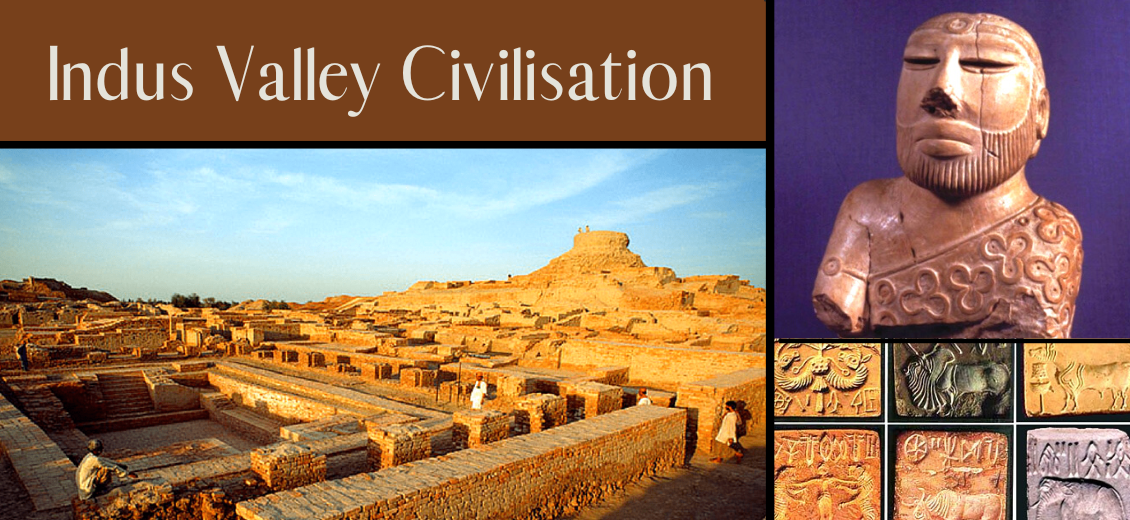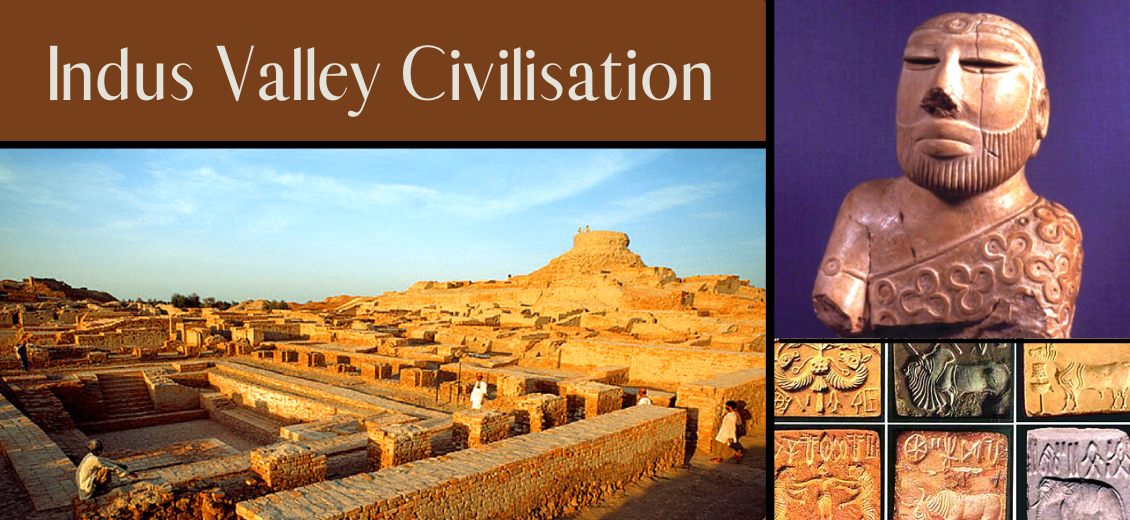
20 Dec 2023
Indus Valley Civilization history GK Quiz Test is useful for those students who are preparing for all Government and competitive exams like SSC CGL, CHSL, CPO, Steno, Banking Exams (SBI PO, IBPS SO, RRB Grade D, LIC AAO), UPSC Civil Service Exams.

25 QUIZ About INDUS VALLEY CIVILIZATION Part 3
Indus Valley Civilization
Indus Valley Civilization history GK Quiz Test is useful for those students who are preparing for all Government and competitive exams like SSC CGL, CHSL, CPO, Steno, Banking Exams (SBI PO, IBPS SO, RRB Grade D, LIC AAO), UPSC Civil Service Exam, CDS, Police, Railway, AAI, NDA, Post Office Exams, BPSC, ACEE, AIEED, APPSC, MPPSC, GPSC, OPPSC, UPPSC, UPSSSC and All-State Selection Commission Exams, and all other one day competitive exams also.
In this set we included important previous year questions also, so start todays test and boost your preparation with Sv Study Alert.
1. Question: Which of the following is a distinctive feature of the script used by the Indus Valley Civilization?
A) Hieroglyphics
B) Logographic symbols
C) Pictographic symbols
D) Alphabetic characters
Solution: C) Pictographic symbols
Explanation: The script used by the Indus Valley Civilization is often described as pictographic, consisting of symbols that represent objects or ideas.
2. Question: What is the primary source of information about the daily life and culture of the Indus Valley Civilization?
A) Religious texts
B) Seals and inscriptions
C) Sculptures and statues
D) Government records
Solution: B) Seals and inscriptions
Explanation: Seals and inscriptions found in the Indus Valley provide valuable insights into daily life, trade, and cultural practices of the civilization.
3. Question: Which city of the Indus Valley Civilization is known for its advanced dockyard and maritime activities?
A) Harappa
B) Mohenjo-daro
C) Lothal
D) Kalibangan
Solution: C) Lothal
Explanation: Lothal is known for its advanced dockyard, indicating the significance of maritime activities and trade in the region.
4. Question: What is the term used for the raised platforms or mounds on which the major structures of the Indus Valley cities were built?
A) Ziggurats
B) Citadels
C) Terraces
D) Mounds
Solution: B) Citadels
Explanation: The raised platforms or mounds on which the major structures were built in the Indus Valley cities are often referred to as citadels.
5. Question: What is the probable function of the "Great Granary" in the Indus Valley city of Mohenjo-daro?
A) Storage of food grains
B) Residential area for elites
C) Administrative center
D) Religious rituals
Solution: A) Storage of food grains
Explanation: The "Great Granary" in Mohenjo-daro is believed to have been used for the storage of food grains, indicating advanced urban planning and management of resources.
6. Question: What is the term used for the small, rectangular seals found in the Indus Valley, often featuring intricate carvings and inscriptions?
A) Cylinder Seals
B) Square Seals
C) Micro Seals
D) Disc Seals
Solution: B) Square Seals
Explanation: The small, rectangular seals found in the Indus Valley are commonly known as Square Seals, and they often feature intricate carvings and inscriptions.
7. Question: Which of the following metals was extensively used for making tools and ornaments in the Indus Valley Civilization?
A) Gold
B) Silver
C) Copper
D) Iron
Solution: C) Copper
Explanation: Copper was extensively used for making tools and ornaments in the Indus Valley Civilization. Bronze, an alloy of copper, was also prevalent.
8. Question: What is the name of the granary found in the archaeological site of Harappa?
A) Great Granary
B) Royal Granary
C) Elite Granary
D) Imperial Granary
Solution: A) Great Granary
Explanation: The granary found in Harappa is known as the Great Granary, emphasizing its significance in storage and management of grains.
9. Question: Which of the following is considered evidence of the advanced urban planning in the major cities of the Indus Valley Civilization?
A) Irregular street layout
B) Lack of public structures
C) Grid-like pattern
D) Absence of drainage systems
Solution: C) Grid-like pattern
Explanation: The major cities of the Indus Valley Civilization, such as Mohenjo-daro and Harappa, are known for their advanced urban planning, featuring a grid-like pattern of streets.
10. Question: What is the term used for the small, square-shaped bricks used in the construction of houses in the Indus Valley Civilization?
A) Adobe bricks
B) Terracotta bricks
C) Mud bricks
D) Kiln-fired bricks
Solution: C) Mud bricks
Explanation: The small, square-shaped bricks used in the construction of houses in the Indus Valley Civilization were primarily made of mud.
11. Question: What is the name of the large public bathhouse discovered in the archaeological site of Mohenjo-daro?
A) Sacred Bath
B) Great Bath
C) Ritual Bath
D) Elite Bath
Solution: B) Great Bath
Explanation: The large public bathhouse discovered in Mohenjo-daro is known as the Great Bath. It is considered one of the significant structures of the Indus Valley Civilization.
12. Question: Which of the following animals is commonly depicted on the seals of the Indus Valley Civilization?
A) Giraffe
B) Rhinoceros
C) Elephant
D) Camel
Solution: C) Elephant
Explanation: The elephant is commonly depicted on the seals of the Indus Valley Civilization, showcasing the significance of this animal in their cultural imagery.
13. Question: What was the likely function of the "Lower Town" in the major Indus Valley cities?
A) Residential area for elites
B) Marketplace and trade center
C) Administrative center
D) Religious rituals
Solution: B) Marketplace and trade center
Explanation: The "Lower Town" in major Indus Valley cities is believed to have served as a marketplace and trade center due to its location and layout.
14. Question: Which of the following materials was not commonly used for making pottery in the Indus Valley Civilization?
A) Terracotta
B) Steatite
C) Bronze
D) Clay
Solution: C) Bronze
Explanation: Bronze was not commonly used for making pottery in the Indus Valley Civilization. Terracotta and steatite were more prevalent materials.
15. Question: What is the name of the site where evidence of a dockyard was discovered, indicating maritime trade in the Indus Valley Civilization?
A) Harappa
B) Mohenjo-daro
C) Lothal
D) Kalibangan
Solution: C) Lothal
Explanation: Lothal is the site where evidence of a dockyard was discovered, suggesting maritime trade activities in the Indus Valley Civilization.
16. Question: What is the term used for the Indus Valley Civilization's practice of constructing structures on massive platforms with a central courtyard?
A) Citadel construction
B) Courtyard architecture
C) Platform planning
D) Raised platform construction
Solution: A) Citadel construction
Explanation: The Indus Valley Civilizatio
Also, below are a few links that may help you score more in the upcoming Government exams: Free Mock Test Series with Solutions Previous Year Government Exams Question Papers PDF with Solutions Daily Current Affairs Free Job Alert ढूंढ रहे हैं सरकारी नौकरी या लेना है कॉलेज में एडमिशन, शिक्षा से लेकर जॉबअलर्ट तक हर लेखा जोखा है SV Study Alert के पास। जॉब अपडेट्स के लिए आज ही फॉलो करें हमारा व्हाट्सअप चैनल - यहां क्लिक करें Are You Looking For A Government Job Or Want To Take Admission In College?, SV Study Alert Has Every Detail From Education To Job Alert. Follow Our Whatsapp Channel Today For Job Updates - Click Here Now NOTE- Svstudyalert.com द्वारा सभी स्टडी मटेरियल हिंदी और अंग्रेजी दोनों भाषाओं में उपलब्ध कराया जाता है ऊपर दिए गए बटन “Choose Your Language” पर क्लिक करके आप सभी स्टडी मैटेरियल हिंदी / अंग्रेजी किसी भी माध्यम में प्राप्त कर सकते हैं |